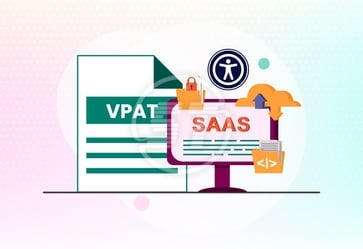Travel has become a trend across the globe. People are traveling more, and this industry is witnessing an upsurge in ROI.
However, interesting to know that is travel accessible to all?
Well, it doesn’t seem so. Although it is possible to build an accessible ecosystem for all travellers. The travel industry can offer ease of access and seamless experience to every potential traveller – abled or differently abled.
Since there are millions of individuals living with some sort of disability, it is important for businesses to focus on them and create accessible digital environments. Prioritizing that specific segment accords additional numbers on profit sheet for businesses. Because no user will want to plan a vacation that becomes an uphill task for them, and accessible websites open a frictionless vacation gateway for them.
Thus, accessibility should be a core practice for tourism websites.
Reasons to embrace accessibility in tourism!
Tourism is for everyone. People with visual, auditory, motor, or cognitive disabilities deserve equal access to the joy of travel – from booking flights and hotels to researching attractions and creating itineraries. When a tourism website is inaccessible, it unintentionally excludes these individuals, diminishing their freedom and limiting business opportunities.
Facts to know:
- Over 1 billion people globally live with some form of disability.
- The accessible tourism market is valued at over $140 billion approx. annually.
- Many countries now mandate accessible digital services in public and private sectors, including travel.
Common accessibility barriers on tourism websites!
Tourism websites often feature dynamic content, maps, images, and interactive booking forms – all of which can create barriers if not designed with accessibility in mind.
Top issues include:
- Missing alt text on destination images, making visual content unreadable for screen reader users. Tourism relies heavily on visuals to showcase destinations, hotels, and more. However, inaccessible images make it difficult for users to perceive those images.
- Inaccessible booking forms prevent keyboard-only users or those using assistive tech from completing bookings/reservations.
- Poor contrast is problematic for users with low vision or color blindness. And overly stylized fonts can be hard to decode for many users with cognitive issues.
- Non-descriptive links – such as “Click here” – give no context to screen readers and confuse users.
- Auto-playing videos or animations without pause options can disorient users with cognitive impairments. No captions exclude users hard of hearing and no transcripts limit access for visually impaired users.
- Navigation complexity, especially in multilingual or content-heavy travel sites. Several travel websites use mega menus, pop-ups, or layered navigation features that may not be accessible to many users depending on screen readers.
- Interactive maps are useful for users to find hotel locations, nearby attractions, or transportation options. However, most map widgets are not accessible. A simple text list of addresses or landmarks can supplement maps to aid accessibility.
Benefits of accessible tourism websites!
Making tourism websites accessible isn’t just ethical – it’s profitable and strategic.
- Wider audience reach: Accessible sites attract older (senior citizens) travellers, people with temporary impairments, and users in different environments (e.g., low lighting or noisy surroundings).
- Improved SEO: Accessible websites often perform better in search engine rankings due to semantic HTML and descriptive metadata.
- Positive brand image: Inclusivity builds trust and loyalty among travellers.
- Legal protection: Compliance with regulations like the ADA (US), EN 301 549 (EU), and RPwD Act (India) minimizes the risk of lawsuits or penalties.
Vital accessibility practices for tourism websites!
Tourism brands can significantly improve their digital inclusivity with thoughtful design and development practices:
- Use alt text for all images: Describe visual elements correctly, especially landmarks or accommodation images.
- Ensure keyboard navigation: All functions should be operable using a keyboard alone.
- Offer text alternatives: Transcripts for videos and captions for multimedia content.
- Use clear, simple language: This helps all users, especially those with cognitive disabilities or non-native language speakers.
- Design responsive layouts: Ensure readability and usability on all screen sizes.
- Test with assistive technologies: Use screen readers, magnifiers, and voice navigation tools to simulate real user experiences.
- Follow WCAG guidelines: The Web Content Accessibility Guidelines (currently version 2.2) offer detailed standards for compliance.
Read this interesting article: Digital Accessibility for Older Adults
Some outstanding examples of accessible tourism platforms!
There are a few tourism companies that applied accessibility in their design and development process and are already leading in tourism industry:
- VisitScotland: VisitScotland provides an “Accessible Holidays” section, detailed accessibility guides, and user-friendly navigation.
- Lonely Planet: Lonely Planet has published guides and stories focused on accessible travel experiences.
A call for inclusive travel planning!
Website accessibility in the tourism industry is an essential requirement to make the world more open, connected, and compassionate. By investing in accessible web design, tourism companies not only comply with global standards but also open doors to a broader audience.
It’s time to make travel planning a joy for everyone, regardless of ability. Inclusive travel begins with inclusive websites!
Is your website compliant with accessibility standards such as WCAG, ADA, and EAA? Whether you're beginning from scratch or enhancing existing compliance, Skynet Technologies provides comprehensive digital accessibility solutions to support your objectives. Our skilled team delivers website accessibility remediation services including accessibility audit, strategic planning, accessible design and development, website and document remediation, VPAT documentation, continuous monitoring, and expert support. Get in touch at hello@skynettechnologies.com or request a custom quote.


